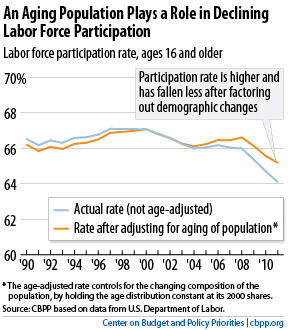BEYOND THE NUMBERS
We noted earlier that the recent drop in labor force participation — the percentage of people 16 or older who are working or looking for work — reflects not only the economic downturn and lack of job opportunities, but also the fact that more baby boomers are hitting retirement age.

Although the “headline” rate includes everybody age 16 or older, labor force participation peaks at ages 25 through 54. Many teens and young adults choose school over work, while many people 55 or older leave the workforce when they retire or become disabled. Crucially, the baby boom generation — the huge cohort of Americans born between 1946 and 1964 — is swiftly moving into that older group. And that’s putting downward pressure on labor force participation.
Our findings support the conclusions of the Congressional Budget Office (CBO) and analysts at the Federal Reserve banks of Chicago and Kansas City, who find that an aging population accounts for an important piece of the recent drop in labor force participation. Those experts generally conclude that about half of the drop in labor force participation since 2007 (the start of the economic downturn), and about a third of the drop since 2000 (when the rate hit its all-time high), stems from an aging population.
That’s only part of the story, of course; CBO notes that “the economic downturn [and] weak growth in output during the recovery” have also dampened participation. In other words, the downturn and lack of job opportunities have driven many people from the labor force and reduced the important employment-to-population ratio.
As we’ve written, stimulus measures could improve labor force participation by boosting job creation. Getting Americans back to work would raise incomes, reduce poverty, enhance retirement security, and lessen pressures on disability insurance and a host of other programs.
But, given the aging of the population, we’re unlikely to get back to the high participation levels of the late 1990s even if the economic recovery grows much stronger.
